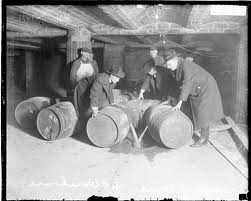Women’s Christian Temperance organizations were created in the late 1800’s to champion social causes. They believed that all  evils in the world created by man start with the consumption of alcohol. They gained great power and influence over the government when women received the right to vote in Canada in 1918.
evils in the world created by man start with the consumption of alcohol. They gained great power and influence over the government when women received the right to vote in Canada in 1918.
Temperance organizations were not limited to Canada they existed all over the world with big organizations existing in Britain, Canada and the U.S.
In 1918 as the Great War was coming to a close the Temperance organizations were able to convince their respective governments that there should be an outright ban on the production, sale and consumption of alcohol for the betterment of civilization. They believed that the Great War was the best example of men acting through evil while drunk.
Many men came home from the war addicted to Navy rum which was widely distributed on the front lines.
The policy was called Prohibition and it spread across North America from 1918 to 1920.
Prohibition did not last long in many Canadian Provinces. Exceptions were made for various profitable industries like the Ontario  wine industry. This prevented people losing jobs. The alcohol industry made too much money for the government to abandon it completely. The loop hole allowed the wine makers to export their products overseas rather than sell to the domestic market. In general prohibition was abandoned by 1927 in Canada and 1933 in the U.S.
wine industry. This prevented people losing jobs. The alcohol industry made too much money for the government to abandon it completely. The loop hole allowed the wine makers to export their products overseas rather than sell to the domestic market. In general prohibition was abandoned by 1927 in Canada and 1933 in the U.S.
While the production, sale and consumption of alcohol was illegal many people began making their own. If they could not make their own they found people who would smuggle alcohol in from other countries. This process is called Bootlegging. Bootlegging quickly became very profitable and linked with organized crime.
The Kennedy family that would later produce many U.S politicians and President JFK made their fortunes moving and selling alcohol from Canada to the U.S illegally.
The most famous Bootlegger in the U.S was gangster Al Capone. Capone created a crime syndicate in Chicago which smuggled Canadian alcohol into the U.S in the late 20’s and early 30’s. He bribed high raking judges and policemen to stay out of his way. Capone almost completely controlled everything in Chicago. One incorruptible policeman Eliot Ness caught Capone and managed to have him convicted of tax evasion, not bootlegging.
When prohibition was put into place bars all over North America closed. In their place illegal institutions called speakeasies sprang up to sell alcohol illegally. Within these places a new type of sound was born. Based in the song styles of the American Black population Jazz sprang up as the new musical sound of the 1920’s and 30’s. Jazz was fast and exciting, music that you could dance to and have a party. Jazz was highly emotional music and spread through the highs of the 1920’s and the lows of the 1930’s thanks to the invention of the Radio. It’s chaotic nature was not appreciated by traditional music lovers and it received great criticism for many years by the mainstream media, however, it was embraced by the youth of the generation. Notable Jazz musicians of the period include King Oliver, Louis Armstrong, and Duke of Ellington. This music quickly inspired another version of Jazz called Swing. Swing artists included big Band musicians like Count Basie and Glen Miller.
